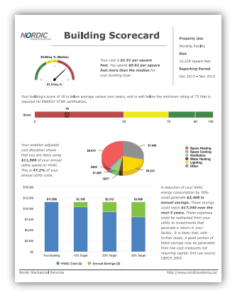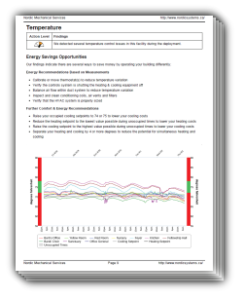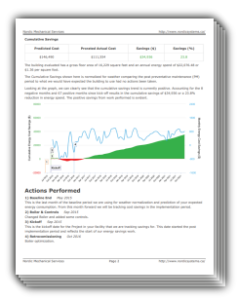Salvation Army’s Edmonton Temple – Measurable Operating Costs Reduction

Driving Measurable Reductions in Operating Costs
How the Nordic team partnered with Salvation Army’s Edmonton Temple to reduce utility bills by over 23% while increasing occupant comfort.
 Worship Facilities can be a challenge to manage. From mixed use to unpredictable schedules and occupancy levels, it’s no wonder that these types of facilities often overspend their utility bills. Knowing the potential of reducing their client’s operating costs by implementing a robust preventative maintenance (PM) program, the Nordic team embarked on a mission to deliver results. This is the story of how they did it.
Worship Facilities can be a challenge to manage. From mixed use to unpredictable schedules and occupancy levels, it’s no wonder that these types of facilities often overspend their utility bills. Knowing the potential of reducing their client’s operating costs by implementing a robust preventative maintenance (PM) program, the Nordic team embarked on a mission to deliver results. This is the story of how they did it.

 Building Scorecard
Building Scorecard
The first step in the Nordic process is to assess the building’s operating budgets to get a clear understanding of financial performance. Since energy utilities are typically the single largest controllable operating cost in a commercial facility, the team needed to gain a quick understanding of how efficiently the mechanical systems were operating versus their peers. The Nordic team gathered total fuel and electricity spend and building profile information. Using Energy Star’s database with its 1-11 scoring systems, the team determined the building had a low score of “16”. Their score indicated the building was a poor performer with plenty of room for improvement. This initial effort indicated further analysis was warranted for both Nordic and the client.
 Building Assessment
Building Assessment
 Through the Building Scorecard and the preliminary survey process, the team confirmed that relative to its peer buildings (house of worship) there was room for improvement. The next phase of their process involved placing wireless sensors measuring Temperatures, Relative Humidity, CO2 Levels, and lighting throughout the facility. This tool documents how the building is controlled and determines if schedules were adhered to. The report validated numerous control and schedule issues including operation during unoccupied times, simultaneous heating and cooling and ventilation control issues. In addition, there were numerous comfort issues uncovered by the sensors that were confirmed by occupants. These findings were assembled and fed into their next stage of the process.
Through the Building Scorecard and the preliminary survey process, the team confirmed that relative to its peer buildings (house of worship) there was room for improvement. The next phase of their process involved placing wireless sensors measuring Temperatures, Relative Humidity, CO2 Levels, and lighting throughout the facility. This tool documents how the building is controlled and determines if schedules were adhered to. The report validated numerous control and schedule issues including operation during unoccupied times, simultaneous heating and cooling and ventilation control issues. In addition, there were numerous comfort issues uncovered by the sensors that were confirmed by occupants. These findings were assembled and fed into their next stage of the process.
Project Financial Analysis
Once the assessment was completed, the team assembled the collection building data and began evaluation options that met specific ROI targets established by Edmonton Temple’s leadership. The Nordic team used the building data to model different options mindful of the need for recommendations to meet ROI targets. Working closely with the client’s leadership they assembled a package that they estimated could drive saving up to 20% by implementing a robust PM program, upgrading an old boiler, and decommissioning the controls system.

 Savings Tracker
Savings Tracker
 As the Nordic team implemented its recommendations, they also implemented an independent effort to track the financial impact of the measures. BuildingAdvice’s SavingsTracker was introduced to track savings. using two years of utility bills for fuel and electricity an energy consumption baseline was established.
As the Nordic team implemented its recommendations, they also implemented an independent effort to track the financial impact of the measures. BuildingAdvice’s SavingsTracker was introduced to track savings. using two years of utility bills for fuel and electricity an energy consumption baseline was established.
As the team implemented measures, they were able to monitor the financial impact using utility bills and comparing them to the baseline. The statistical model BuildingAdvice uses takes weather into account so that if, for instance, Edmonton experienced a colder than normal winter, the model will “normalize” for that.
The continuous feedback helps the team adjust their priorities each quarter. The team’s efforts have doubled Edmonton Temple’s Energy Star score from a low of “16” to “34”. To date, the effort has also reduced consumption by 23.8% generating $34.936 in savings.














